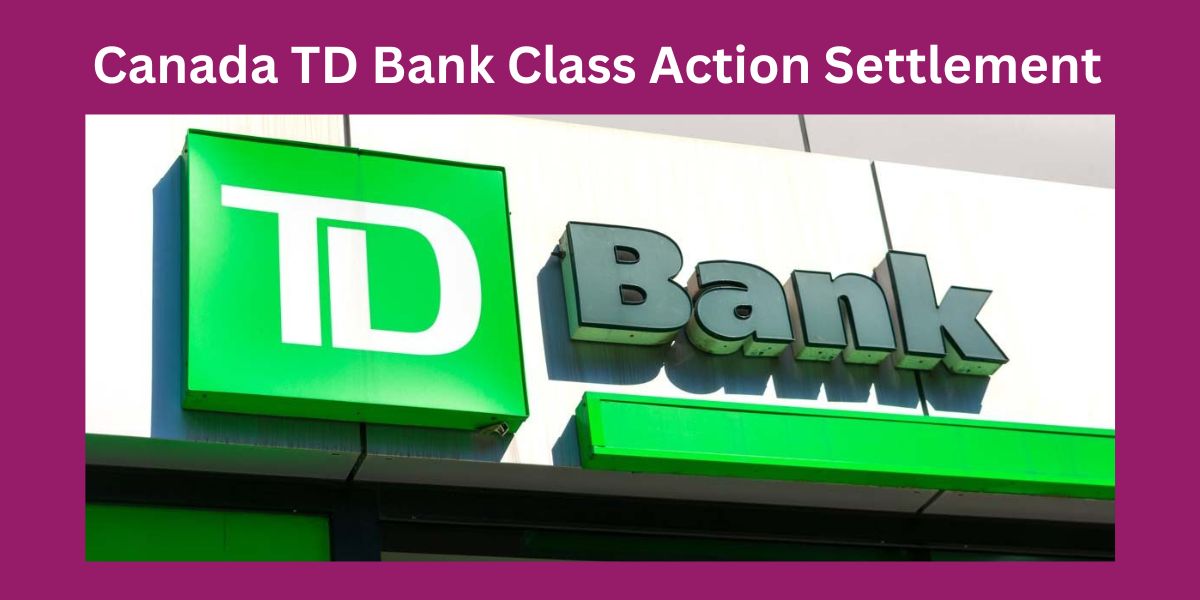The world of banking can often feel like a maze with twists, turns, and unexpected surprises. Recently, TD Bank in Canada found itself at the center of a class action lawsuit, stirring quite a buzz among its customers. If you’ve ever banked with TD or know someone who has, you might wonder what this is all about. So, let’s break it down and find out what this settlement means for you, how much you could potentially receive, and whether you qualify for a piece of the pie.
What’s the Deal with the TD Bank Class Action Settlement?
You might be wondering, “What exactly is a class action settlement?” Good question! Essentially, a class action lawsuit is when a group of people who have suffered similar harm come together to sue a company or institution—in this case, TD Bank. The lawsuit alleged that TD Bank charged its customers certain fees inappropriately, and as a result, customers felt they were unfairly treated. The settlement is the bank’s way of resolving the dispute without admitting any wrongdoing.
Why Was TD Bank Sued?
To put it simply, TD Bank was taken to court over fees. The plaintiffs in this case accused TD Bank of charging fees that were not fully disclosed or were unfair in their application. These fees included overdraft fees, maintenance fees, and other charges that some customers felt were not communicated clearly. The core of the lawsuit was transparency—or the lack thereof—regarding these fees.
The Heart of the Matter: Overdraft Fees
Have you ever gone slightly over your balance, thinking, “It’s just a few dollars, no big deal,” only to be slapped with a hefty overdraft fee? You’re not alone. Overdraft fees have been a major bone of contention in the lawsuit against TD Bank. Customers argued that they were hit with multiple fees when their accounts went negative, which they felt was excessive and unfair.
Hidden Fees and the Fine Print
The lawsuit also highlighted the issue of hidden fees. Let’s face it, no one enjoys reading the fine print, and banks often rely on that. But when those tiny lines of text lead to charges that you weren’t expecting, that’s where things get tricky. Many customers felt blindsided by fees they didn’t know existed or didn’t understand fully, leading to frustration and, eventually, legal action.
Who Is Eligible for the Settlement?
Now, let’s get to the burning question: “Am I eligible for this settlement?” If you were a TD Bank customer and experienced any of these contested fees during a specific period, you might be in luck. The eligibility criteria typically include:
- Current or Former TD Bank Customers: You must have had an account with TD Bank during the period in question.
- Affected by the Fees: You must have been charged one or more of the fees cited in the lawsuit—overdraft fees, maintenance fees, etc.
- Timeline: The period in question often covers several years, so even if you were a customer a while back, it’s worth checking.
How to Check Your Eligibility
Wondering how to find out if you’re eligible? Start by looking at any communication from TD Bank about the settlement. They might have sent letters or emails to those impacted. If you’re still unsure, you can visit the official settlement website or contact the settlement administrator for more details.
How Much Could You Receive?
Alright, let’s talk money. If you’re eligible, how much could you be looking at? The settlement amount varies depending on several factors, such as how much you were charged in fees and the total number of claimants. Here’s a general breakdown:
- Base Compensation: A set amount for every eligible claimant.
- Additional Compensation: Depending on the fees you were charged, you might receive more.
- Percentage of Fees Paid: In some cases, the settlement might offer a percentage back of the fees you paid.
Understanding the Payout Calculation
The payout can seem complicated, but it’s usually calculated based on a formula that considers the total settlement amount and the number of claimants. The goal is to distribute the funds fairly, so everyone gets a piece proportional to the fees they paid.
Steps to Claim Your Share
Okay, so you’re eligible and want to claim your share—what’s next? Here’s a simple guide to help you through the process:
- Submit a Claim Form: This is usually available on the official settlement website. You’ll need to provide your personal details and any information about your account and the fees you were charged.
- Proof of Fees: Sometimes, you might need to show proof of the fees you paid. This could mean digging up old bank statements or transaction records.
- Wait for Processing: Once you’ve submitted your claim, there’s a waiting period while the settlement administrator processes everything. This can take several months, so patience is key!
Avoiding Common Pitfalls in the Claim Process
Many people miss out on their share because they don’t submit the form correctly or miss the deadline. Double-check your information, ensure all required documents are attached, and keep a copy of everything for your records.
What If You Don’t Qualify?
Not everyone will qualify for the settlement, and that’s okay. If you don’t meet the criteria, you won’t be eligible to receive any compensation. However, this doesn’t mean you’re out of options. Consider:
- Reviewing Your Bank Statements: Look for any fees that seem off or were not clearly explained. Even if you’re not part of this lawsuit, you can always address your concerns directly with TD Bank.
- Switching Banks: If you’re unhappy with TD Bank’s practices, this might be a good time to explore other banking options that better fit your needs.
Impact of the Settlement on TD Bank and Its Customers
What does this settlement mean for TD Bank moving forward? Well, apart from the financial impact, it’s likely to change how the bank communicates fees and charges to its customers. The bank might implement new policies or improve transparency to regain customer trust.
How Will This Affect Future Banking Practices?
Banking is all about trust, and cases like this can shake that foundation. To prevent future lawsuits, banks, including TD, will likely tighten up their fee structures and enhance customer communication. This could mean clearer terms, more straightforward fee disclosures, and perhaps even fewer fees overall.
What Can You Learn from This Settlement?
Even if you’re not a TD Bank customer or eligible for the settlement, there are still some key takeaways here:
- Always Read the Fine Print: As tedious as it might be, understanding the terms and conditions of your bank account can save you a lot of headaches (and money) down the line.
- Keep Track of Your Fees: Regularly review your bank statements to ensure you’re not being charged unexpectedly. If something looks off, don’t hesitate to ask your bank for clarification.
- Know Your Rights: As a consumer, you have rights. If you feel that a bank is treating you unfairly, you have the option to take action—whether that’s joining a class action lawsuit, filing a complaint, or simply switching banks.
What Does This Mean for the Future of Class Action Lawsuits?
The TD Bank settlement is just one of many class action lawsuits we see in the banking world. As consumers become more aware of their rights, and as banks continue to walk the tightrope of profitability and fairness, we can expect more cases like this in the future.
Are More Settlements on the Horizon?
With more and more consumers speaking up about unfair practices, banks might see an uptick in lawsuits. It’s a reminder for all financial institutions to prioritize transparency and fairness in all their dealings.
Conclusion
The TD Bank class action settlement is a significant event in the Canadian banking sector, reminding us all about the importance of transparency and fairness. Whether you’re a current or former customer, it’s worth checking your eligibility to see if you’re entitled to any compensation. And even if you’re not, this situation offers valuable lessons on keeping an eye on your finances and knowing your rights as a consumer. The world of banking can be complex, but staying informed and vigilant can help you navigate it more confidently.
FAQs
1. How do I know if I’m eligible for the TD Bank class action settlement?
To determine eligibility, check any communications from TD Bank or visit the official settlement website. If you were charged the fees in question during the specified period, you might be eligible.
2. What fees are covered under the TD Bank class action settlement?
The settlement covers overdraft fees, maintenance fees, and other charges that the lawsuit alleges were unfairly applied or not properly disclosed to customers.
3. How long does it take to receive my settlement payment?
Once you submit your claim form, the processing can take several months. Payments are distributed only after all claims are reviewed and approved.
4. Can I still take legal action if I accept the settlement?
By accepting the settlement, you typically waive the right to pursue further legal action on the same issue. Review the settlement terms carefully before making a decision.
5. What if I miss the deadline to submit my claim?
If you miss the claim deadline, you may forfeit your right to receive compensation from the settlement. Always check the deadline and ensure your claim is submitted on time.










